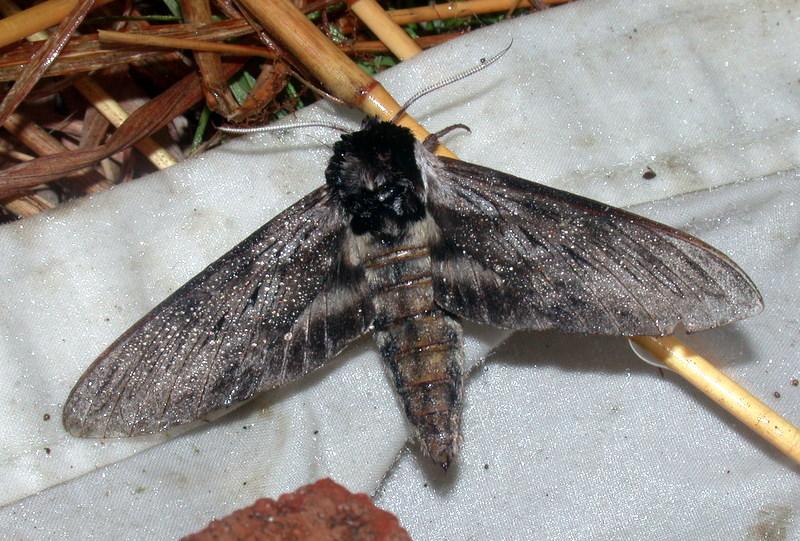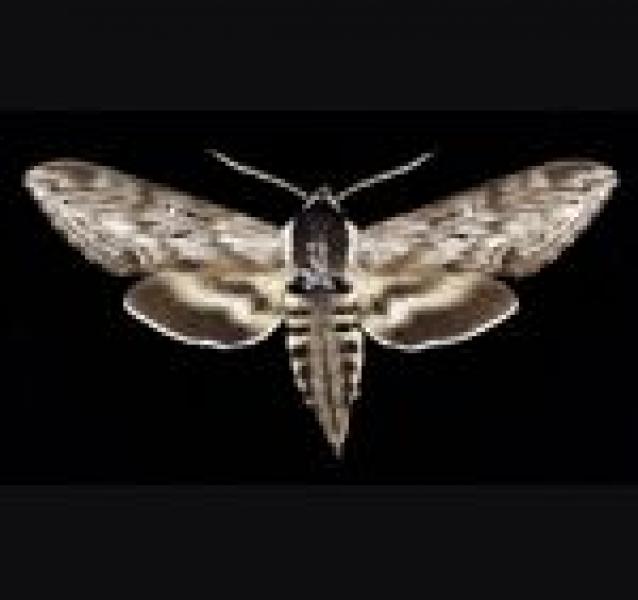Gordian Sphinx
Sphinx gordius Cramer, 1779
- Class
- Insecta (Insects)
- Family
- Sphingidae (Sphinx or Hawk Moths)
- State Protection
- Not Listed
Not listed or protected by New York State.
- Federal Protection
- Not Listed
- State Conservation Status Rank
- S3
Vulnerable in New York - Vulnerable to disappearing from New York due to rarity or other factors (but not currently imperiled); typically 21 to 80 populations or locations in New York, few individuals, restricted range, few remaining acres (or miles of stream), and/or recent and widespread declines.
- Global Conservation Status Rank
- G4G5
Apparently or Demonstrably Secure globally - Uncommon to common in the world, but not rare; usually widespread, but may be rare in some parts of its range; possibly some cause for long-term concern due to declines or other factors. More information is needed to assign either G4 or G5.
Summary
Did you know?
The Gordian Sphinx, also known as the Apple Sphinx, is in a group of moths known as the Hawk Moths. Hawk moths are the world's fastest flying insects. The fastest one was measured at 50 kph (31 mph).
Conservation and Management
Conservation Strategies and Management Practices
The best management strategy for this species is the management of the natural community, or habitat, where this species occurs. Maintaining the Long Island pine barrens with their full suite of plant and animal species requires frequent (every few decades) disturbance to maintain open-canopy, shrub-dominated communities and to prevent succession to a closed-canopy, hardwood forest (Jordan et al. 2003). Researchers have determined that "an active fire management program utilizing prescribed fire with appropriate mechanical treatments" is the preferred method (Jordan et al. 2003). Researchers have also determined that the size, type, intensity, and timing of fires (pyrodiversity) needs to be evaluated for each site to maximize benefits to the natural community and the species it supports (Jordan et al. 2003). The entire occupied habitat for a population should not be burned in a single year. For example, in places where prescribed burning is used, refugia (unburned areas) are needed for many species to ensure that any life stage can survive a fire.
Research Needs
Additional surveys are needed with blacklight traps to determine the extent of the dwarf pine barrens occurrence and to locate new occurrences. In addition, research is needed on the response of this species to prescribed (controlled) burning and mechanical treatment to improve habitat.
Habitat
Habitat
In New York State, the Gordian Sphinx is known only from the dwarf pine barrens on Long Island. These open, dry woodlands are dominated by a mixture of dwarf pitch pine and scrub oak. Common shrubs are black huckleberry, blueberries, and sweetfern.
Associated Ecological Communities
- Dwarf pine plains
(guide)
A woodland community dominated by dwarf individuals of pitch pine and scrub oak that occurs on nearly level outwash sand and gravel plains in eastern Long Island. The soils are infertile, coarse textured sands that are excessively well-drained.
- Pitch pine-oak forest
(guide)
A mixed forest that typically occurs on well-drained, sandy soils of glacial outwash plains or moraines; it also occurs on thin, rocky soils of ridgetops. The dominant trees are pitch pine mixed with one or more of the following oaks: scarlet oak, white oak, red oak, or black oak.
- Pitch pine-oak-heath woodland
(guide)
A pine barrens community that occurs on well-drained, infertile, sandy soils. The structure of this community is intermediate between a shrub-savanna and a woodland. Pitch pine and white oak are the most abundant trees.
Associated Species
- Burgess's Apamea (Apamea burgessi) (guide)
- Herodias Underwing (Catocala herodias)
- Jair Underwing (Catocala jair)
- Melsheimer's Sack Bearer (Cicinnus melsheimeri) (guide)
- Packard's Lichen Moth (Cisthene packardii) (guide)
- Projecta Gray (Cleora projecta) (guide)
- Pine Tussock Moth (Dasychira pinicola) (guide)
- A Geometrid Moth (Euchlaena madusaria) (guide)
- Fringed Dart (Eucoptocnemis fimbriaris) (guide)
- Violet Dart (Euxoa violaris) (guide)
- Coastal Barrens Buckmoth (Hemileuca maia ssp. 5) (guide)
- A Prominent Moth (Heterocampa varia) (guide)
- Yellow-spotted Graylet (Hyperstrotia flaviguttata) (guide)
- Pale Green Pinion Moth (Lithophane viridipallens) (guide)
- Pin-striped Slug Moth (Monoleuca semifascia) (guide)
- Gray Woodgrain (Morrisonia mucens) (guide)
- Pink Sallow (Psectraglaea carnosa) (guide)
- Spinose Flower Moth (Schinia spinosae) (guide)
- Barrens Itame (Speranza exonerata) (guide)
- Toothed Apharetra (Sympistis dentata) (guide)
- Orange Holomelina (Virbia aurantiaca) (guide)
- Pine Barrens Zale (Zale lunifera) (guide)
Range
Global Distribution
The Gordian Sphinx is found from southern New England and New York west through central Illinois, to southern Wyoming, and northern Utah and Colorado. Farther south, it is found in a narrow band from North Carolina through Tennessee to Missouri, and in Florida. To the north, it is known from North Dakota and Manitoba (North American Moth Photographers Group at the Mississippi Entomological Museum, account compiled by N. Schneider, no date).
Best Places to See
- Dwarf Pine Barrens (Suffolk County)
Identification Comments
Identifying Characteristics
A specimen or a very good image is needed to identify this species. The wingspan ranges from 68-95 mm. The color and markings are highly variable. Typically the thorax is black with grayish-brown edges near the wing bases. The forewing is blackish to gray with white dusting. The hind wing is black and brown with a white fringe (Covell 1984).
Diet
Larvae of this species have a variety of host plants including apple, sweetfern, Carolina rose, blueberry, huckleberry, white spruce, larch, and alder. Adults feed on nectar from flowers such as dogbane, honeysuckle, lilac, evening primrose, bouncing bet, and phlox.
Best Time to See
The larvae (caterpillars) of this species pupate in burrows in soft soil. There is typically one brood each year. Flight dates of adults range from May to September.
- Present
- Reproducing
The time of year you would expect to find Gordian Sphinx present and reproducing in New York.
Gordian Sphinx Images
Taxonomy
Gordian Sphinx
Sphinx gordius Cramer, 1779
- Kingdom Animalia
- Phylum Arthropoda
(Mandibulates)
- Class Insecta
(Insects)
- Order Lepidoptera
(Butterflies, Skippers, and Moths)
- Family Sphingidae (Sphinx or Hawk Moths)
- Order Lepidoptera
(Butterflies, Skippers, and Moths)
- Class Insecta
(Insects)
- Phylum Arthropoda
(Mandibulates)
Comments on the Classification
Older records for this species might include specimens now considered to be Sphinx poecillus, which is a northern and more common species.
Additional Resources
References
Covell, Charles V. 1984. A field guide to the moths of eastern North America. Houghton Mifflin Company, Boston.
Holland, W. J. 1903. The moth book. A guide to the moths of North America. Doubleday, Page & company, New York. 479 pp.
Jordan, M. 1998. Ecological effect of a large and severe summer wildfire in the Long Island dwarf pine barrens. Unpublished report. The Nature Conservancy, Long Island Chapter, Cold Spring Harbor, NY.
Jordan, M. J., W. A. Patterson III, A. G. Windisch. 2003. Conceptual ecological models for the Long Island pitch pine barrens: implications for managing rare plant communities. Forest Ecology and Management 185, 151-168.
Little, S. 1979. Fire and plant succession in the New Jersey pine barrens. pp. 297-313 in Forman, R.T.T. (ed.) Pine Barrens: Ecosystem and Landscape. Academic Press, Inc. Orlando, FL.
McGuinness, Hugh D. 2009. Moths of fire: a study of the macro-lepidoptera in burned and unburned plots at the New York State Department of Environmental Conservation's Sarnoff Preserve in Flanders, Suffolk County, New York. 2006-2008. Report for the Long Island Chapter of The Nature Conservancy.
McGuinness, Hugh. 2006. Overview of the 2005 Dwarf Pine Plains data.
Mississippi Entomological Museum. No date. Mississippi State University. Mississippi. http://mississippientomologicalmuseum.org.msstate.edu//index.html.
NatureServe. 2010. NatureServe Explorer: An online encyclopedia of life [web application]. Version 7.1. NatureServe, Arlington, Virginia. Available http://www.natureserve.org/explorer. (Data last updated August 2010)
New York Natural Heritage Program. 2024. New York Natural Heritage Program Databases. Albany, NY.
North American Moth Photographers Group at the Mississippi Entomological Museum. No date. Mississippi State University, Mississippi. http://mothphotographersgroup.msstate.edu/MainMenu.shtml
Opler, Paul A., Kelly Lotts, and Thomas Naberhaus, coordinators. 2010. Butterflies and Moths of North America. Bozeman, MT: Big Sky Institute. <http://www.butterfliesandmoths.org/> (accessed May 2010).
Links
About This Guide
This guide was authored by: Lauren Lyons-Swift
Information for this guide was last updated on: April 18, 2019
Please cite this page as:
New York Natural Heritage Program. 2024.
Online Conservation Guide for
Sphinx gordius.
Available from: https://guides.nynhp.org/gordian-sphinx/.
Accessed July 26, 2024.

